Just because an aircraft takes off (or lands in) from a certain stretch of land, one cannot deem the area an ‘airport’. After all, aircraft are capable of landing on a highway too. During an emergency, a Piper PA-28 landed on a New York City interstate highway, reported the BBC. Various nations have flight test centers, where newly developed aircraft – whether it be civil or military – are tested but such expanses aren’t dubbed to be airports either. According to Ernest J. Gentle’s Aviation and Space Dictionary, an airport is defined as:
“An area of land or water that is used or intended to be used for the landing and takeoff of aircraft, and includes its buildings and facilities, if any. The term airport is normally used to describe U.S. civil facilities whereas airfield is a U.S. military facility. Aerodrome is an international term.”
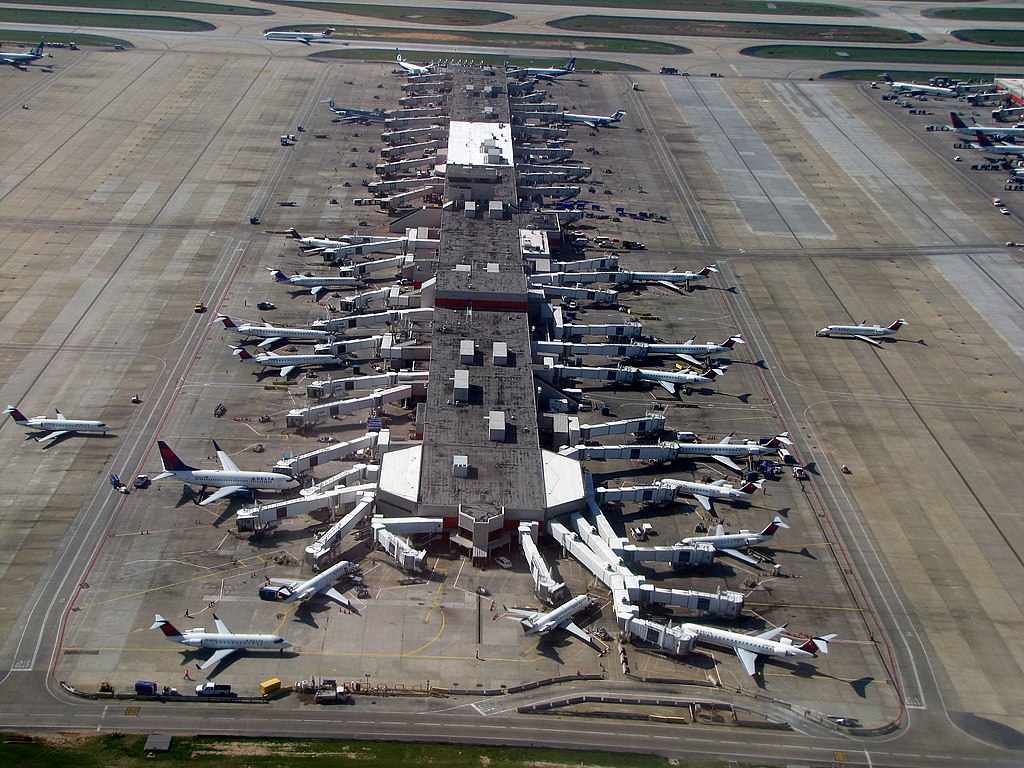
Image: redlegsfan21 | Wikimedia Commons
If an aircraft devoid of passengers takes off and lands from one field and lands on another then, the “field” cannot be termed “airport/ aerodrome/ airstrip”. If this were not the case, the first ever flight (conducted by the Wright Brothers) would have meant that Kill Devil Hills – the place in North Carolina where they took the first heavier-than-air machine to the skies – was the oldest airport. But this is not the case, despite their aircraft flying for 12 seconds above the sand dunes of Kitty Hawk.
Though on 14 May 1908, Wright brothers made history again with the world’s first two passenger airplane flights, Kill Devil Hills is still not considered as the oldest airport in the world. It’s dubbed as “Field of firsts”, or the First Flight Airport (FAA). The Field of Firsts was established in 1928 but the date of establishment of the oldest airport in the world is 1909.
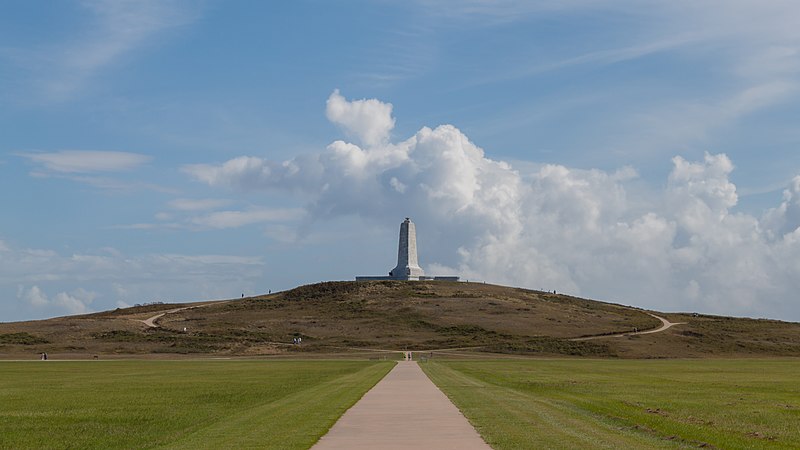
The area near which the Wright Brothers took to the skies has now turned into ” Wright Brothers National Memorial” near Kitty Hawk
Photo: Kip Robinson | Wikimedia Commons
In this article, we will take a look at the oldest airports in the US. Despite these being the oldest airports in the US (and one of them also being the oldest airport int he world), none of these airports fall in the list of the busiest airports in the world.
5. Chicago Midway Airport (MDW)

Owner: The City of Chicago
Established in: 1927
Hub for: Southwest Airlines (operates 229 daily flights- more than any other U.S. airport that Southwest flies from.)

Notable operators
- Porter Airlines
- North Country Sky
- Delta Air Lines
- Volaris Airlines
Airport type: Public
Airport property
Location: Chicago’s Southwest Side between 55th and 63rd Streets and Cicero and Central Avenues
Area coverage: 640 acres (approximately)
Chicago Midway International Airport (MDW) is the second- largest airport in Chicago, consisting of 1 terminal with 3 concourses. There are 43 aircraft gates among which three gates serve as inbound international passengers. Midway became home to 15 scheduled airlines by 1950.
The Chicago Department of Aviation (CDA) manages MDW. Commissioner Jamie L. Rhee has been managing this airport and also been serving in it over the course of 29 years by being in multiple positions.
| 4 runways | Length (meter) | Width (meter) | Type | Condition | Light intensity |
| 13R/31L | 1,176 | 18 | Concrete | Excellent | Medium |
| 13C/31C | 1,988 | 46 | Concrete | Good | medium |
| 4R/22L | 1,964 | 46 | Asphalt /concrete/grooved | Excellent | High |
| 4L/22R | 1,679 | 46 | Asphalt | Good | Medium |
How was the airport named?
The Chicago Midway Airport was renamed Midway in honor of the hard fought Battle of Midway in the Pacific during World War II.
Interesting facts related to Chicago Midway Airport:
- Chicago leadership and airline officials celebrated the completion of the Terminal Development Program in 2004.
- Midway recorded its highest passenger in the airport’s 85-year history in 2012. More than 19.5 million passengers were recorded at that time. In 2013 it served more than 20 million passengers.

Photo: Ken Lund | Wikimedia Commons
Updates of Chicago Midway Airport:
The CDA held a grand opening for The Club MDW, the first-ever shared use passenger lounge in Midway’s 96-year history in 2024. There are 2 lounges at MDW, including The Club MDW and the USO Lounge. More than 51,000 people travel through Chicago Midway Airport on Sunday alone. So, Sunday is expected to be the busiest day at this airport.
4. Long Beach Airport (LGB)
Owner and operator: The City of Long Beach
Established in: 1924
Notable operators
- Southwest Airlines
- Hawaiian Airlines
- Skywest Airlines
- Mesa Airlines
- Delta Airlines
Airport type: Public
Airport property
Location: City of Long Beach, California
Area coverage: 1,166 acres

Long Beach Airport (LGB) has 11 gates with a single terminal. The intuitive layout makes the navigating operation easier in this airport and the presence of three baggage claim areas enhances the overall travel experience, making it easy for passengers to retrieve their luggage quickly. It offers service to 24 nonstop destinations around the nation.

Cynthia Guidry is the director of this airport. She was honored by The Conference of Minority Transportation Officials (COMOTO) during the national organization’s 12th annual “Women Who Move the Nation” award ceremony in 2023. The honor was bestowed upon her for her efforts to leading the airport through COVID -19, alongside overseeing “several major developments as part of LGB’s ongoing $110 million multi-year, Phase II – Terminal Area Improvement Program”
| 3Runways
Type: Asphalt |
Length (meter) | Width (meter) | Used by | Light intensity |
| 12/30 | 3,048 | 61 | Passenger Airlines and cargo services | High (Edge lighting) |
| 8L/26R | 1,887 | 46 | Commercial and General Aviation (GA) | Medium |
| 8R/26L | 1,194 | 30 | GA | High |
How was the airport named?
Long Beach Airport is known as Daugherty Field. It is because former Army Air corps flight instructor Earl Daugherty started a 20- acre flight training field. Also, Daugherty was a plane builder and “the greatest stunt pilot” of his time.
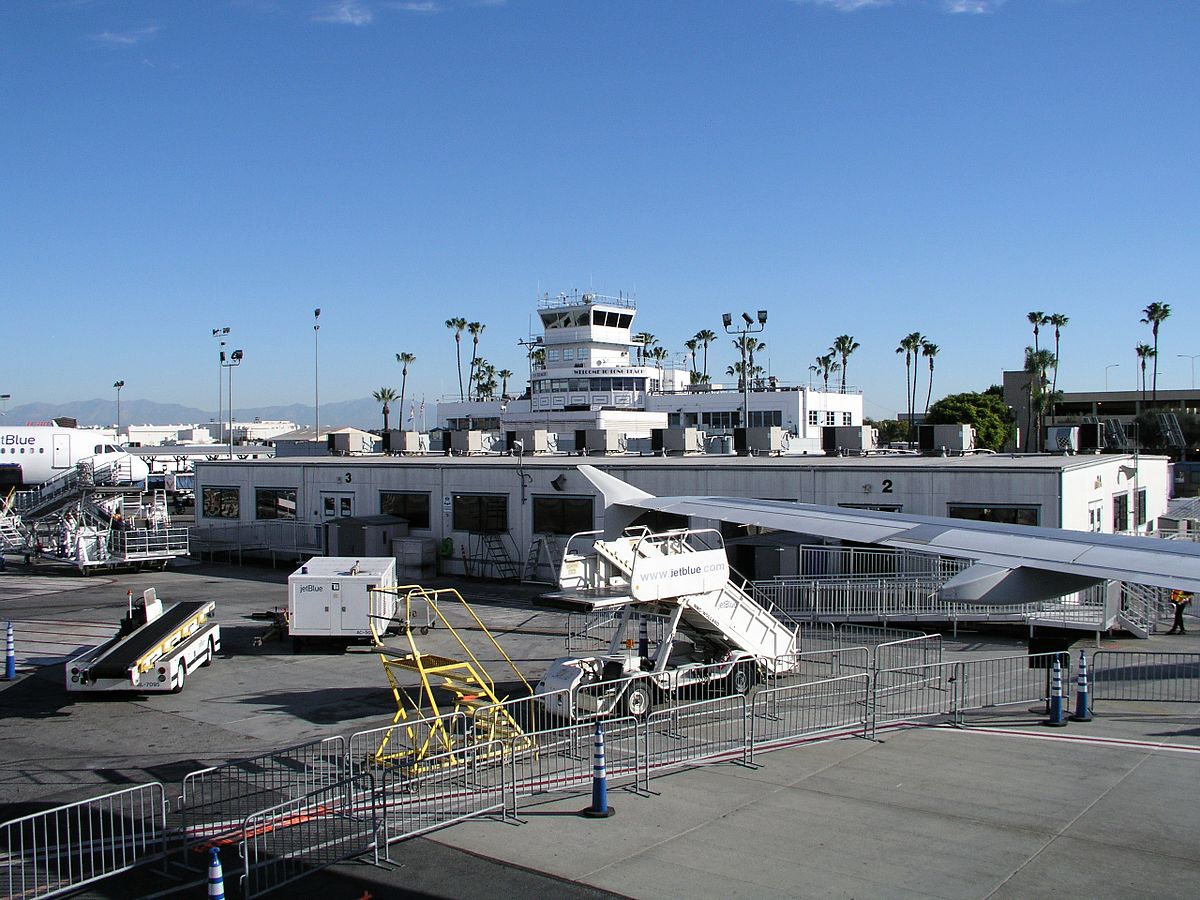
Photo: Merikamp | Wikimedia Commons
Interesting facts related to Long Beach Airport:
- LGB is California’s Oldest Municipal Airport.
- The Douglas Aircraft company’s Long Beach manufacturing plant was the first to feature air conditioning in the US.
- Carl Rogers’ first transcontinental “Vin Fiz” flight landed on the beach in 1911.
- In 1928, for night use, Field lit was installed. LGB became the first illuminated airport in the country.
- In 1941, LGB was declared No. 1 airport in the country for total aircraft operations.
- In 1990, LGB was declared a historic landmark by the city’s Cultural Heritage Commission.
- In 2021, the leading industry group for airports, Airports Council International certified LGB with a level 2 rating in the Airport Carbon Accreditation (ACA) Program.
- The second phase of airport improvement began in 2020 which cost $110 million and two major parts were completed in 2022.
- LGB celebrated its 100th anniversary on Nov. 26, 2023.
Update of Long Beach Airport:
The Long Beach Airport’s newly renovated historic terminal building, which was first opened in1942, was officially open from July 27, 2024. LGB celebrated its 100th birthday with a new slogan: “America’s Coolest Airport!”, reported CBS News.
3. Minneapolis Saint Paul International Airport (MSP)

Owner: The Metropolitan Airports Commission (MAC)
Established in: 1920 (104 years ago)
Airport type: Joint Civil-military public international airport
Hub for: Delta Airlines (2nd largest hub)
Notable operator:
- Sun Country Airlines (hometown carrier)
Sun Country Airlines. Photo: Wikimedia Commons

Photo: Cory W. Watts | Wikimedia Commons
Airport property
Location: Minnesota
Area coverage: 3,400 (approx.)
Terminal buildings: 2 (Terminal 1 and Terminal 2)
Minneapolis Saint Paul International Airport offers non-stop flights to 114 domestic and 20 international markets. Minneapolis Saint Paul International Airport boasts two terminals and four runways. Metropolitan Airports Commission is the owner and operator of Minneapolis Saint Paul International Airport. Brian Ryks is the CEO and Executive Director of the Minneapolis Airport Commission.
| 4 Runways Type: concrete | Length (meter) | Width (meter) | Light intensity | Purpose |
| 4/22 | 3,355 | 46 | Medium | A longer runway for takeoff and landing |
| 12R/30L | 3,048 | 61 | A PAPI system | Peak traffic periods and when flight factors promote a north flow |
| 12L/30R | 2,499 | 46 | Medium | For arrivals and departures |
| 17/35 | 2,438 | 46 | Centerpoint lights and a PAPI system | Departures to the south to augment flow of air traffic |
Note: PAPI = Precision Approach Path Indicator
- Runways 30L and 30R (parallel runways): first priority for arrivals since aircrafts approach MSP from the southwest over industrial use areas.
- Runways 12 L and 12R: lowest priority for arrivals from the northwest since aircraft approach MSP over densely- populated residential areas.

Photo: Michael Barera | Wikimedia Commons
Interesting facts related to Minneapolis Saint Paul International Airport:
- MSP earned No.1 ranking among mega airports in the newly released J.D. Power 2024 North America Satisfaction Study.
- It earned the highest customer satisfaction rankings for each of the seven airport dimensions that form the basis for the overall award.
- MSP served more than 31 million travelers in 2022 making it the 19th busiest U.S. airport for passengers and 21st for aircraft operations.
- It was named the 2017 top North American airport for efficiency excellence in its size category by the Air Transportation Research Society.
- Airports Council International- North America recognized MSP as the best of any large airport in North America.
- Skytrax named MSP’s staff as the best in North America in 2016.
Updates of Minneapolis Saint Paul International Airport
In September, 2024, the Minnesota SAF Hub announced the first shipment of blended SAF (made from Minnesota/North Dakota-grown winter camelina) to the Minneapolis-St. Paul International Airport fueling facility. MSP is also working with Pentair to deliver high-quality drinking water while reducing the need for single-use plastic water bottles by installing 10 Hope Hydration HydroStations for the millions of travellers who visit and fly through the airport every year.
2. Stinson Municipal Airport (SSF)

Owner: The City of San Antonio
Established: 1915
Airport type: Private and corporate travel/ General aviation
Notable operators:
- Air Canada
- Air France
- American airlines
- Emirates
- Etihad airways
- IAG Cargo
- Lufthansa Cargo
- Qatar Airways
- Turkish Cargo
- United Cargo
Airport property
Location: seven miles south of downtown San Antonio in Bexar County, Texas
Area coverage: 500 acres of farmland
Terminals: Four (1, 2, 3 and International)
The City of San Antonio is the operator of Stinson Municipal Airport. It was established by the Stinson family of aviation pioneers. It is funded by the City of San Antonio and Texas Department of Transportation. Until the late 1920s and early 1930s, Stinson Municipal Airport was used by barnstormers and experimental pilots. A major capital project to expand the terminal was completed in 2008.
| 2 runways Type: Paved /Asphalt | Length | Width | Light intensity (runway edge light) | Purpose |
| 09/27 | 1,524 | 30 | Medium | Aircraft takeoff and landing |
| 14/32 | 1,258 | 30 | Medium | Improves aircraft circulation |
Interesting facts related to Stinson Municipal Airport
- Stinson Municipal Airport serves as a backup for San Antonio International Airport (SAT).
- During the Stinson Municipal Aiport”s first years in operation, the Stinson family flying school trained many World War I pilots.

- Stinson Field’s name was changed for nine years to “Windburn Field” following an aeroplane crash of reporter Bill Windburn on October 15, 1927.
- It celebrated its 100th anniversary in 2015.
- SSF had a record breaking number of passengers as 10,676,570 people used the airline in 2023.
Updates of Stinson Municipal Airport:
Since Stinson Municipal Airport serves as a backup for San Antonio International Airport, in March 2024, Ron Nirenberg, mayor of San Antonio, Texas in an announcement hinted about how the airport is likely to grow in size in next few years:
“ San Antonio International Airport is in the midst of a very historic time, this is our time…By mid 2028, you’ll be walking in a brand new terminal with up to 17 additional international gates and this means greater connectivity for our region spurring jobs, international mobility, economic development and strategic growth.”
In the same event, director of SAT, Jesus Saenz Jr. added that both SAT and SSF are worthy of making an impression on international level.
1. College Park Airport (ICAO: KCGS, IATA and FAA LID: CGS)
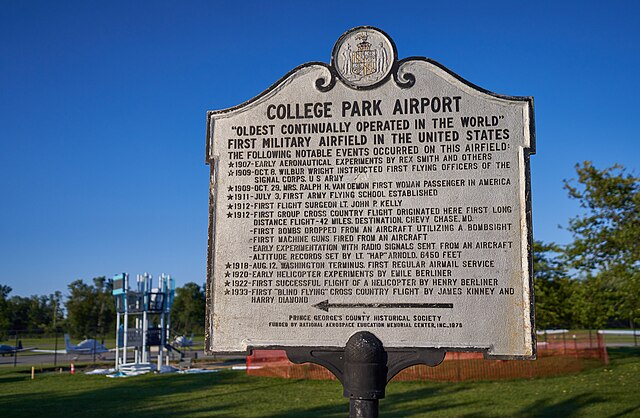
Owner: Maryland-National Capital Park & Planning Commission
Established in: 1909
Airport type: Public
Status: Operational
Airport property
Location: College Park, Maryland
Area coverage: 70 acres of land
Maryland-National Capital Park & Planning Commission is the operator of the oldest airport in the US – the College Park Airport. It was established by the United States Army Signal Corps. Initially, it was built to serve as a training location for Wilbur Wright to instruct two military officers to fly in the government’s first airplane. Leo Sommer is the Airport manager and Drew Myers is the Assistant Airport Manager at CGS, Maryland.
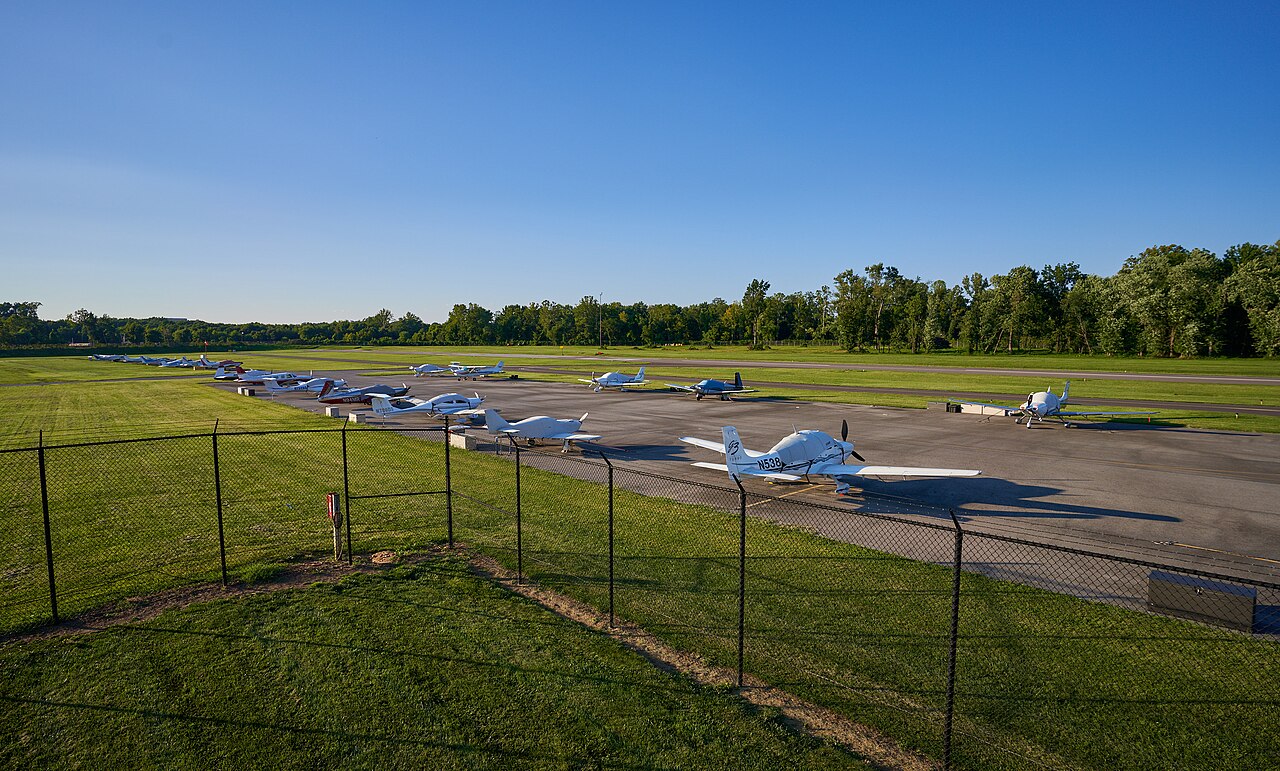
Photo: Black Tupelo | Wikimedia Commons
| Runway | Length | Width | Type | Condition | Light intensity |
| 15/33 | 908 m | 18 m | Asphalt | Good | Medium |
Interesting Facts related to College Park Airport:
- Not only in the US, College Park Airport is the oldest airport in the world.
- In 1911, CGS started offering civilian flights and served as the nation’s first military aviation school.
- “Field of Firsts”: the site of the first mile-high flight by a powered plane, the first female passenger, the first controlled helicopter flight, and the first night landing.

- The National Register of Historic Places added the College Park Airport as the world’s oldest continuously operated airport in 1977. The flying operation of civilian aircraft began in 1911.
- The first airplane, a Wright Type A biplane, was uncrafted and assembled on October 7, 1909.
Updates of College Park Airport:
According to the Environmental Protection Agency, roughly 13,000 aviation airports in the U.S. release 468 tons of lead into the atmosphere every year. College Park Airport burned 14.1 pounds of lead in 2020. According to the FAA, all forms of lead are toxic.
